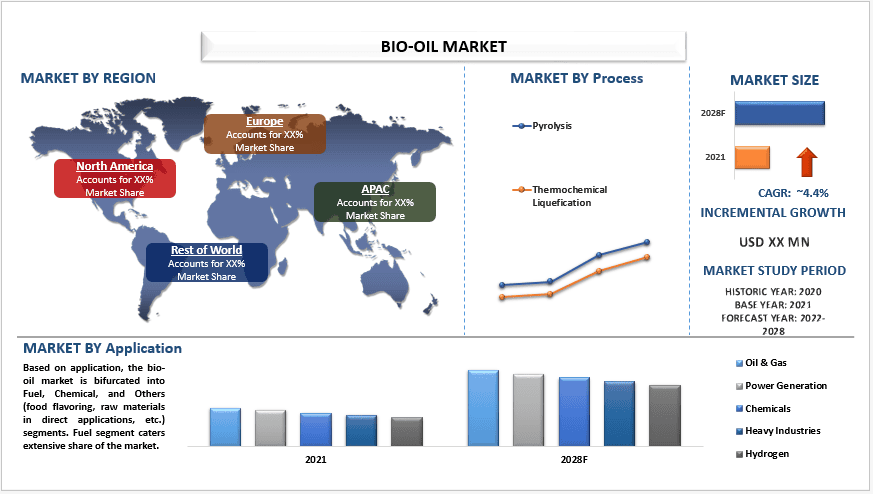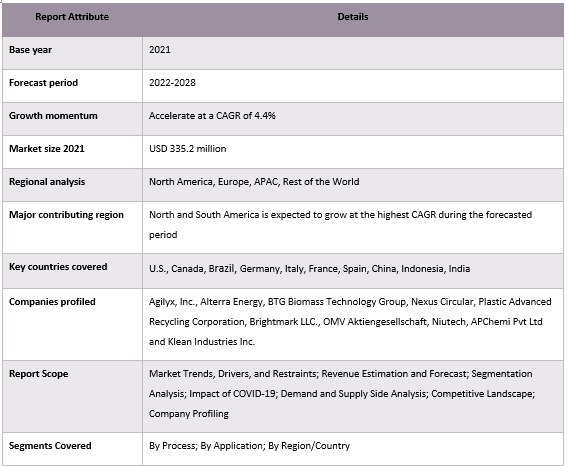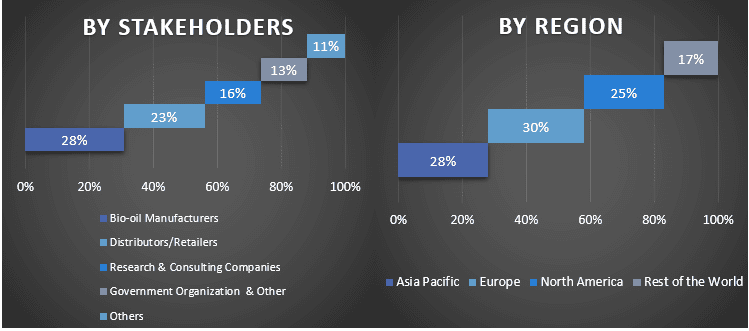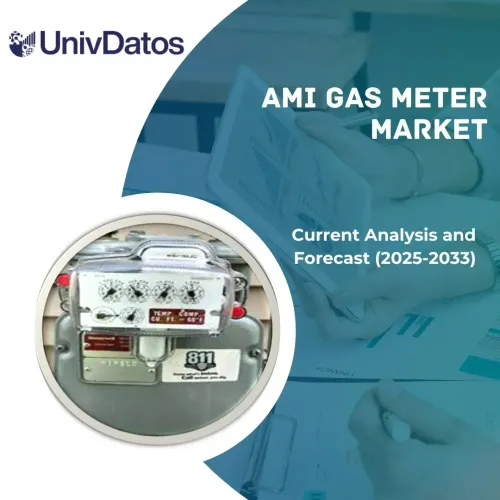- Home
- About Us
- Industry
- Services
- Reading
- Contact Us
Bio-oil Market: Current Analysis and Forecast (2022-2028)
Emphasis on Process (Pyrolysis and Thermochemical Liquefication); Application (Fuel, Chemical, and Others (food flavoring, raw materials in direct applications, etc.)); and Region/Country

Bio-oil market was valued at USD 335.2 million in 2021 & is expected to grow at a CAGR of 4.4% from 2022-2028. Moreover, the need to meet net zero emission goals across the globe in various countries and rising consumer awareness towards environmentally friendly products are acting as a catalyst in the growth of bio-oil globally during the projected period.
Further, in addition, key players in the market are also launching new products and technology in the market to increase the yield of bio-oil and produce cleaner versions of oil. The majority of governments have formulated new policies in order to support the growth of renewable fuel. The government of India introduced “The National Policy of Biofuel 2018” which aims to promote biofuel and increase government incentives in the biofuel sector. The policy provides an indicative target of 20% ethanol blending in petrol under the Ethanol Blended Petrol Programme by 2030. The current ethanol blend stands at 10%, however, the government has started promoting biofuel in India.
Some of the major players operating in the market include Agilyx, Inc., Alterra Energy, BTG Biomass Technology Group, Nexus Circular, Plastic Advanced Recycling Corporation, Brightmark LLC., OMV Aktiengesellschaft, Niutech, APChemi Pvt Ltd and Klean Industries Inc.
Several M&As along with partnerships have been undertaken by these players to facilitate customers with hi-tech and innovative products/technologies.
Insights Presented in the Report
“Amongst process, the pyrolysis segment held a dominating share of the market in 2021”
Based on process, the Bio-oil market is bifurcated into Pyrolysis and Thermochemical Liquefication segments. Pyrolysis captured a majority share of the market and is expected to register the highest growth during the forecasted period as well. Bio-oil is obtained via an array of thermochemical processes. The most common of these processes are pyrolysis and hydrothermal liquefaction. The thermochemical liquefaction process is less attractive compared to the fast pyrolysis process as it produces a lower yield of bio-oil and requires additional catalysts or other reactants to facilitate the process which is a major drawback. The fast pyrolysis process is favorable as it can maximize the yield of bio-oil by approximately 80% based on dry feed and operational conditions used.
“Amongst applications, the fuel segment held the majority share of the market in 2021”
Based on application, the bio-oil market is bifurcated into Fuel, Chemical, and Others (food flavoring, raw materials in direct applications, etc.) segments. The fuel segment captured an extensive share of the market and is expected to grow at a significant rate in the forecasted period as well. The bio-oil can be used for heat and power generation, liquid fuels, and various raw chemical products such as asphalt binder, adhesive, resins, food flavoring, and agrichemicals. Bio-oil is a major substitute for conventional oil but the renewable fuel industry is still very niche, and the price of bio-oil is not competitively priced when compared to traditional fuel. However, many governments and industries have started investing in sustainable fuel which has increased the research in bio-oil and new technological advancements will make bio-oil a strong substitute for conventional fuel in the future.
“North and South America dominated the Bio-oil market in 2021”
North and South America acquired more than half of the market share in the Bio-Oil market and is expected to witness an influential CAGR in the forecasted period. It is mainly owing to a large number of Bio-Oil operational projects taking place in Canada, the United States of America, and Brazil. Moreover, favorable government policies, regulations, and investments in achieving net zero emission targets are driving the market. For instance: In the United States, the Sustainable Aviation Grand Challenge Roadmap aims to improve understanding of the feedstock challenge, boost supply potential, and support new technology development. In Canada, a USD 1.1‑billion Clean Fuels Fund supports supply chain development. Policies focused on GHG emissions reductions can also be useful since they give biofuel producers an incentive to reduce the GHG intensity of their fuels, not just produce more.
Bio-oil Market Report Coverage

Reasons to buy this report:
- The study includes market sizing and forecasting analysis validated by authenticated key industry experts.
- The report presents a quick review of overall industry performance at one glance.
- The report covers an in-depth analysis of prominent industry peers with a primary focus on key business financials, product portfolios, expansion strategies, and recent developments.
- Detailed examination of drivers, restraints, key trends, and opportunities prevailing in the industry.
- The study comprehensively covers the market across different segments.
- Deep dive regional level analysis of the industry.
Customization Options:
The global Bio-oil market can further be customized as per the requirement or any other market segment. Besides this, UMI understands that you may have your own business needs, hence feel free to connect with us to get a report that completely suits your requirements.
Table of Content
Research Methodology for the Bio-oil Market Analysis (2022-2028)
Analyzing the historical market, estimating the current market, and forecasting the future market of the global Bio-oil market were the three major steps undertaken to create and analyze the adoption of Bio-oil in major regions globally. Exhaustive secondary research was conducted to collect the historical market numbers and estimate the current market size. Secondly, to validate these insights, numerous findings and assumptions were taken into consideration. Moreover, exhaustive primary interviews were also conducted, with industry experts across the value chain of the global Bio-oil market. Post assumption and validation of market numbers through primary interviews, we employed a top-down/bottom-up approach to forecasting the complete market size. Thereafter, market breakdown and data triangulation methods were adopted to estimate and analyze the market size of segments and sub-segments of the industry pertains to. Detailed methodology is explained below:
Analysis of Historical Market Size
Step 1: In-Depth Study of Secondary Sources:
Detail secondary study was conducted to obtain the historical market size of the Bio-oil market through company internal sources such as annual reports & financial statements, performance presentations, press releases, etc., and external sources including journals, news & articles, government publications, competitor publications, sector reports, third-party database, and other credible publications.
Step 2: Market Segmentation:
After obtaining the historical market size of the Bio-oil market, we conducted a detailed secondary analysis to gather historical market insights and share for different segments & sub-segments for major regions. Major segments are included in the report as process and application. Further country-level analyses were conducted to evaluate the overall adoption of testing models in that region.
Step 3: Factor Analysis:
After acquiring the historical market size of different segments and sub-segments, we conducted a detailed factor analysis to estimate the current market size of the Bio-oil market. Further, we conducted factor analysis using dependent and independent variables such as process and application of the Bio-oil market. A thorough analysis was conducted for demand and supply-side scenarios considering top partnerships, mergers and acquisitions, business expansion, and product launches in the Bio-oil market sector across the globe.
Current Market Size Estimate & Forecast
Current Market Sizing: Based on actionable insights from the above 3 steps, we arrived at the current market size, key players in the global Bio-oil market, and market shares of the segments. All the required percentage shares split, and market breakdowns were determined using the above-mentioned secondary approach and were verified through primary interviews.
Estimation & Forecasting: For market estimation and forecast, weights were assigned to different factors including drivers & trends, restraints, and opportunities available for the stakeholders. After analyzing these factors, relevant forecasting techniques i.e., the top-down/bottom-up approach were applied to arrive at the market forecast for 2028 for different segments and sub-segments across the major markets globally. The research methodology adopted to estimate the market size encompasses:
- The industry’s market size, in terms of revenue (USD) and the adoption rate of the Bio-oil market across the major markets domestically
- All percentage shares, splits, and breakdowns of market segments and sub-segments
- Key players in the global Bio-oil market in terms of technology offered. Also, the growth strategies adopted by these players to compete in the fast-growing market
Market Size and Share Validation
Primary Research: In-depth interviews were conducted with the Key Opinion Leaders (KOLs) including Top Level Executives (CXO/VPs, Sales Head, Marketing Head, Operational Head, Regional Head, Country Head, etc.) across major regions. Primary research findings were then summarized, and statistical analysis was performed to prove the stated hypothesis. Inputs from primary research were consolidated with secondary findings, hence turning information into actionable insights.
Split of Primary Participants in Different Regions

Market Engineering
The data triangulation technique was employed to complete the overall market estimation and to arrive at precise statistical numbers for each segment and sub-segment of the global Bio-oil market. data was split into several segments & sub-segments post studying various parameters and trends in the areas of the process and application in the global Bio-oil market.
The main objective of the Global Bio-oil Market Study
The current & future market trends of the global Bio-oil market were pinpointed in the study. Investors can gain strategic insights to base their discretion for investments on the qualitative and quantitative analysis performed in the study. Current and future market trends determined the overall attractiveness of the market at a regional level, providing a platform for the industrial participant to exploit the untapped market to benefit from a first-mover advantage. Other quantitative goals of the studies include:
- Analyze the current and forecast market size of the Bio-oil market in terms of value (USD). Also, analyze the current and forecast market size of different segments and sub-segments
- Segments in the study include areas of the process and application.
- Define and analysis of the regulatory framework for the Bio-oil industry
- Analyze the value chain involved with the presence of various intermediaries, along with analyzing customer and competitor behaviors of the industry
- Analyze the current and forecast market size of the Bio-oil market for the major region
- Major countries of regions studied in the report include Asia Pacific, Europe, North America, and the Rest of the World
- Company profiles of the Bio-oil market and the growth strategies adopted by the market players to sustain in the fast-growing market
- Deep dive regional level analysis of the industry
Related Reports
Customers who bought this item also bought










